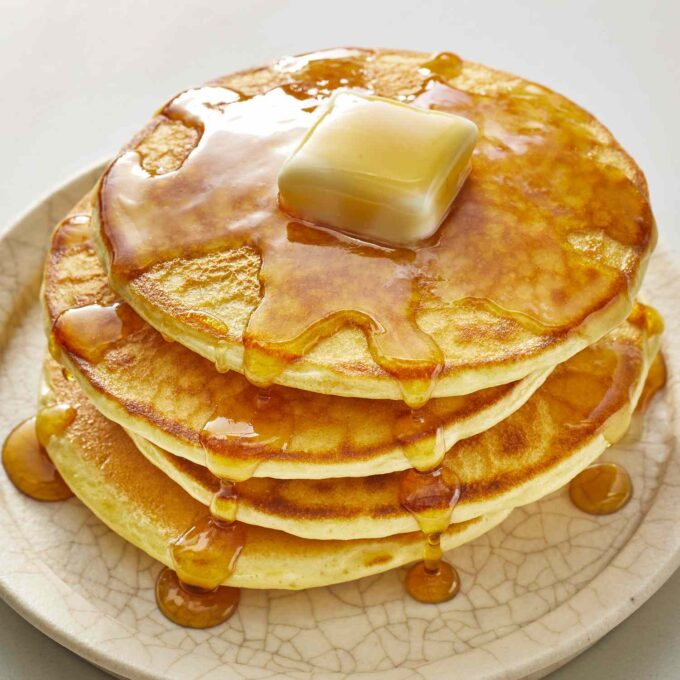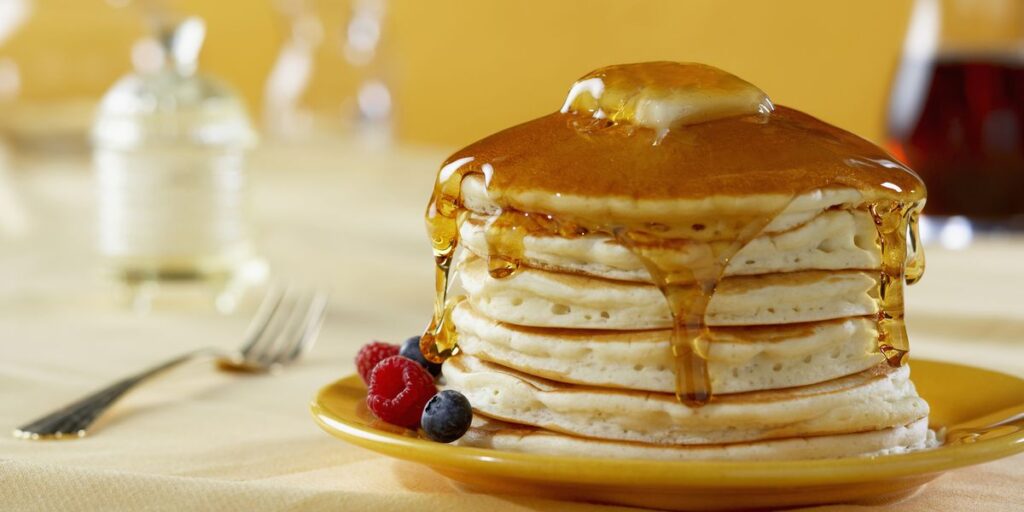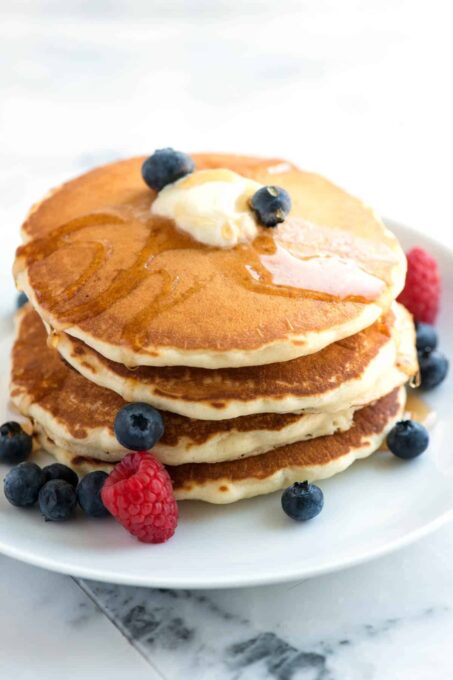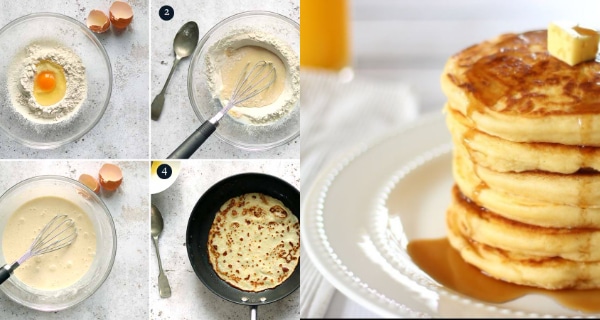“How to make pancakes” – the very thought of fluffy, warm pancakes stacked high and drizzled with syrup is enough to make anyone’s mouth water. Pancakes are a classic breakfast dish that is loved by people of all ages, and it’s no wonder why.
They are easy to make, delicious, and versatile, and they can be customized to suit a variety of tastes and dietary needs. In this guide, we’ll walk you through the process of making perfect pancakes. From start to finish, you’ll find everything you need to know to make delicious pancakes that your family will love. So, let’s get started.
Pancakes were likely one of the earliest forms of processed grain and were made using simple ingredients like flour, water, and eggs. Over time, as ingredients became more readily available, the recipe evolved to include sugar, milk, and other ingredients, leading to the fluffy and delicious pancakes that we know today.
Making Pancakes has made history as a staple food in many cultures, with each culture putting its own unique spin on the dish. Today, pancakes are enjoyed all over the world, with countless variations and recipes, and are considered comfort food for people of all ages.

Pancake Recipe
A good pancake recipe is important because it ensures that pancakes will be a tasty, nutritious, and enjoyable food that anyone can make and enjoy. A good recipe provides a foundation for creativity and experimentation, allowing you to customize the pancakes to suit your tastes and preferences.
Learn how to make peanuts here.
Ingredients for Pancakes
1 cup all-purpose flour
2 tablespoons sugar
2 teaspoons baking powder
1/2 teaspoon salt
1 cup milk
1 egg
2 tablespoons unsalted butter, melted
How to make pancake batter
In a large mixing bowl, whisk together the flour, sugar, baking powder, and salt for the dry mixture.
In a separate bowl, beat together the milk, egg, and melted butter for the wet mixture.
Pour the wet mixture into the dry mixture and whisk until just combined. A few lumps are okay, but try to avoid overmixing.
Let the batter sit for 5-10 minutes to allow the baking powder to activate and the mixture to thicken slightly.
If the batter seems too thick, you can thin it out with a little extra milk. You can thicken it with a little extra flour if it seems too thin.
Your pancake batter is now ready to be cooked!
Tips:
Let the batter sit for a few minutes before cooking to allow the baking powder to work.
Don’t over-mix the batter, as this can lead to tough pancakes. A few lumps are okay.
Step by Step instructions to cook the pancake
Heat a large non-stick pan or griddle over medium heat. If the pan is not non-stick, lightly grease it with cooking oil or melted butter.
Scoop 1/4 cup of batter onto the pan for each pancake. Use the back of the scoop or a spoon to spread the batter into a circle.
Cook the pancake until the edges start to look set and the top is covered in bubbles, about 2-3 minutes.
Flip the pancake using a spatula. Cook until the other side is lightly golden brown, about 1-2 minutes.
Repeat steps 2-4 for the remaining batter, adjusting the heat as necessary to ensure that the pancakes cook evenly.
Serve the pancakes hot with your favourite toppings, such as syrup, butter, fruit, or whipped cream. Enjoy!
SEE: How to Make Oha Soup
Tips:
Use a large, non-stick pan or griddle to ensure even cooking and easy flipping.
Keep cooked pancakes warm in a low oven while you finish cooking the rest of the batter.

Other Ingredients for pancakes recipe.
Various ways of making pancakes depend on the individual and their palate.
The ingredients below are optional and can be added to taste, depending on the desired flavour and texture of the pancake you want.
Sugar: Adds a touch of sweetness to the pancakes.
Vanilla extract: Adds a warm, comforting flavour to the pancakes.
Spices: Cinnamon, nutmeg, or other spices can be added to the batter for extra flavour.
Fruit: Fresh or dried fruit can be mixed into the batter or served as a topping.
Nuts: Chopped nuts can be mixed into the batter or used as a topping.
Chocolate chips: Mini chocolate chips can be mixed into the batter for a chocolate chip pancake.
Buttermilk: Substituting buttermilk for regular milk can result in tangier, slightly denser pancakes.
Yoghurt: Adding a spoonful of yoghurt to the batter can create fluffier, tangier pancakes.
READ:
Toppings for Pancake
Maple syrup: is the traditional and most commonly used syrup for pancakes, but there are many other options available, such as honey, agave, fruit syrups, and even chocolate syrup.
Butter: A simple pat of butter on top of warm pancakes provides rich, creamy flavour and texture.
Fresh fruit: such as berries, sliced bananas, or peaches, add a burst of flavour and colour to pancakes.
Whipped cream: Whipped cream adds a touch of indulgence to pancakes and can be flavoured with vanilla or other extracts.
Chocolate chips: Chocolate chips add a touch of sweetness and chocolatey goodness to pancakes.
Nutella: Nutella is a hazelnut-chocolate spread that is a popular topping for pancakes, especially for those with a sweet tooth.
Baked apples: Top pancakes with sliced baked apples, a drizzle of caramel sauce, and a sprinkle of chopped pecans for a warm and comforting flavour.
Peanut butter: Peanut butter provides a nutty and salty contrast to the sweetness of the pancakes, making it a popular topping choice.
Honey: A drizzle of honey on top of pancakes provides a sweet and natural flavour that compliments the pancakes.

CHECK THESE:
Pancakes Serving Suggestions
Here are some serving suggestions for pancakes at different times of the day:
Breakfast: For breakfast, pancakes are often served with syrup and butter and sometimes with fresh fruit, bacon, or sausage.
Brunch: For brunch, pancakes can be dressed up with more elaborate toppings, such as whipped cream, fresh berries, and a drizzle of chocolate sauce.
Dessert: For dessert, pancakes can be served with a scoop of ice cream, a drizzle of caramel or chocolate sauce, and fresh fruit.
Snack: For a snack, smaller pancakes or mini pancakes can be topped with peanut butter, honey, or a sprinkle of powdered sugar.
Dinner: For dinner, savoury pancakes, such as cheese or herb pancakes, can be served as a side dish with roasted meats, vegetables, or a salad.
No matter the time of day, pancakes are a versatile food that can be dressed up or down to suit the occasion.
RELATED READ: How to cook fried rice one step at a time
Dietary Adaptations for Pancake
Keto: To make keto pancakes, use almond flour or coconut flour in place of traditional flour, and use a low-carb sweetener, such as stevia or monk fruit sweetener, in place of sugar.
Dairy-free: To make dairy-free pancakes, use non-dairy milk, such as almond or oat milk, in place of dairy milk, and use dairy-free butter or oil in place of regular butter.
Gluten-free: To make gluten-free pancakes, use a gluten-free flour blend or a gluten-free baking mix in place of traditional flour. There are many gluten-free flour blends available that can be used in place of wheat flour to make pancakes.
These are just a few examples of dietary adaptations that can be made to pancakes to fit different dietary needs and preferences.
SEE: Tastiest Nigerian Foods to Try Out
Conclusion
Having the right recipe makes the right pancakes.
Consistency: A good pancake recipe ensures that the pancakes will turn out consistently every time so that you can expect the same results each time you make them.
Flavour: A good pancake recipe will have the right balance of ingredients to create a delicious and satisfying taste.
Texture: A good pancake recipe will result in fluffy and tender pancakes, not dense or rubbery.
Appearance: A good pancake recipe will produce golden brown and visually appealing pancakes, making them more appealing to eat.
Nutritional value: A good pancake recipe contains nutritious ingredients, essential nutrients, and energy.
Having a good pancake recipe is essential for making delicious, fluffy, and satisfying pancakes that can be enjoyed as a breakfast, snack, or dessert. With the right recipe, pancakes can be versatile dishes that can be adapted to suit a variety of tastes and dietary needs.

